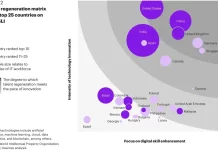
There can be little doubt as to the economic importance of the Middle East and North Africa (MENA). A tide of contrasting change has swept over the region in the last decade, but reinvigorated financial models have emerged from the darkness of recession and political turmoil and now jostle for position on the world stage. Some of the MENA economies could easily propel themselves forward as pacesetters of the next decade. Others, however, seem rather stuck – or set in their ways – and experience prolonged stagnation. At the Davos Summit of the World Economic Forum, the region, and its destiny, remains near the top of the agenda.
Fortunes across the MENA Region often rise and fall in tandem with the price of oil. The geographic area is home to eight of the thirteen OPEC (Organisation of the Petroleum Exporting Countries) member states. While its share of world oil production has declined to about 35% – from a high of around 55% in the mid-1970s – the cartel still holds slightly more than 80% of the world’s proven oil reserves. As such, OPEC still largely determines the price of oil on the global market.
As with most products, supply and demand sets the price. This logic does, however, come with a few caveats. OPEC member states meet every two years to set production quotas based on demand forecasts. Set too low, and the world’s advanced economies end up ordering more than anticipated, pushing prices upwards. Conversely, if set too high, demand for oil tapers off, depressing prices.
The futures market also has its say. Here traders go either long or short on oil, betting vast quantities of duly leveraged monies on the commodity’s ups and downs. Traders do plenty more than just gamble and have been known to buy up futures way above the going rate which then leads to producers hoarding vast quantities of oil in anticipation of higher prices. This effectively shuts the valves and drains the pipelines – inflating prices as in a self-fulfilling prophesy. It is one way of securing a princely income.
As with most annual gatherings organised by the World Economic Forum, the prospects of the MENA Region draw considerable attention. This is, after all, a vast area characterised by an unusually large discrepancy between the current state of affairs and its almost limitless potential. The thinking of WEF participants more often than not centres on the region’s pivotal role as a supplier of oil and little more. Geopolitical stability is sought in order that oil may flow unobstructed onto the world market. Less attention is paid to finding ways of cashing in MENA’s demographic dividend. With a young and often well-educated population yearning to break out of chronic underdevelopment, MENA may before long comprise a large number of buoyant economies seeking to plug into the global economy.
The possibilities are manifold. Should political stability be attained, the countries of North Africa – sun-drenched, sparsely populated, and well-located – can easily provide Europe with all the solar power the continent could ever require. The blueprints of large-scale solar power projects have already been drawn up. Their deployment is held back only by fears of continued civil and religious strife.
The region’s more advanced economies are already opening up to cross-border trade and investment, looking to source future growth from closer integration with the countries of both Europe and the Far East. With Iran at long last opening up for business – after Jordan, Lebanon, Egypt, and Morocco showed the way – investors from within and without the region are spoilt for choice. Gulf Cooperation Council (GCC) states have already taken the lead in underwriting Egypt’s economic and social renaissance while Morocco attracts increased volumes of investments from Europe.
Finding paths to accelerated economic growth is no mere academic exercise either as most MENA countries have little choice in pursuing their demographic dividend, lest it becomes a political liability instead of an economic windfall. High youth unemployment and a lack of opportunity with little chances for upward social mobility, provide for an explosive mix of ingredients that may yet blow up and scuttle the best-laid development matrix.
Iran is expected to feature prominently in both the main discussion at Davos and the various spin-off sessions. The lifting of international sanctions is expected to generate both known and unexpected effects on the future development of Iran’s standing in the world – and its oil market.
The importance of the country’s return to the global oil market cannot easily be underestimated – particularly as the sudden injection of a million barrels/day could, potentially, see oil prices drop by as much as 14 per cent by mid-2016.
Britain also stands to profit massively from the removal of Iran’s shackles. The country’s trade all but ceased during the sanctions with exports believed to have fallen by an astonishing $17 billion from 2012 to 2014. Leading the pack of countries set to benefit by opening new – and reopening old – trade channels is the UK, followed closely by China, Turkey, and India.
Oil revenues are expected to deliver the biggest boost to Iran’s resurgence. Just the revamping of Iran’s now largely obsolete extractive infrastructure is expected to generate tens of billions of dollars in new business.
As if that figure isn’t tantalising enough, there is enough foreign direct investment (FDI) looming on the horizon to give Iran possibly the biggest “welcome back” party the world has ever seen. Following the tightening of sanctions in 2012, the volume of FDI dropped close to zero. However, analysts suspect a tidal wave of investment to start flooding into Iran with the World Bank predicting up to $4 billion worth of one-way transactions to fill reach Iran before 2017 is out.


































